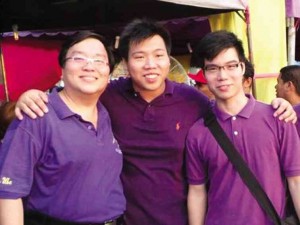
After watching a TV report on the largest mooncake in the Philippines, I decided to pay Binondo a visit.
According to Geric Chua, who belongs to the fourth generation of the Chua clan that founded Eng Bee Tin, the mooncake festival is one of the least celebrated in the Philippines. This shouldn’t be so, he said.
The desire to make the festival more popular led Eng Bee Tin to make the giant mooncake. It is 75 inches in circumference, 24 inches in diameter, 3 inches thick, 45 kg in weight, with 40 kg lotus seed paste as filling and a 5-kg crust.
People flocking to the Eng Bee Tin store have their photos taken with the giant mooncake. They are given free mooncakes to try. “We want to let people enjoy its unique taste,” Geric said.
This year, the mooncakes have had a makeover of sorts.
Tapping a mooncake expert from China, Eng Bee Tin worked on the “skin” (crust) of the mooncake, so that it is now perfectly even, thin, smooth and golden.
The giant mooncake sells for P38,888.88. Proceeds will be donated to a cause very close to Eng Bee Tin’s heart—fire prevention. The store supports fire volunteers.
“Both my Dad and I started very young in firefighting,” said Geric. “We have put together the largest volunteer firefighting organization in the Philippines, Txtfire.”
Through the decades, Binondo in Manila, or what is known as Chinatown, has become known for the best volunteer fire-fighting unit in the city. It began as the residents’ response to the frequent fires in their community.
Geric said Txtfire has more than 4,500 affiliate firefighters nationwide.
“We have donated 10 fire trucks and two ambulances, and we have a coffee shop, Café Mezzanine, that for 15 years has been donating 100 percent of its revenues to our firefighting cause. We also have Mr. Ube Rice and Noodle House that aims to buy five ambulances for the public to use for free.”
The ube-colored fire trucks you see around town are the result of the Chuas’ social-oriented efforts.
There is reason for the color.
Chua Chiu Hong put up Eng Bee Tin on Ongpin Street in Binondo, Manila, in 1912.
It became famous for its traditional Chinese delicacies, such as hopia, tikoy and glutinous balls.
In the ’70s, according to Geric, Eng Bee Tin became just one of the many stores selling Chinese delicacies in Binondo.
“Creditors, suppliers and friends were turning a cold shoulder, wary of doing business with a seemingly doomed enterprise,” said Geric. “The business needed a miracle to survive the 1980s.”
Turning 21 years old, Gerry Chua, Geric’s dad, took over the business fueled by the desire to turn it around.
One fine day, Gerry felt the need to cool off with some ice cream, after a day of slow business. He made his way to the supermarket, where he asked the saleslady what ice cream flavor was the bestseller. “Ube,” the saleslady said.
“Gerry then took six ube jars, and blended the ube with hopia,” said Geric. “After tasting it, he knew he was on to something.
“He traveled to Pampanga to master the art of ube-making under the tutelage of the best halayang ube makers.”
He patiently worked on his ube hopia. When the ube flavor was introduced, orders trickled in. Things eventually picked up.
The family gives credit to Cory Quirino for featuring Gerry’s hopiang ube on her TV show back then, “CitiLine.” After the episode feature, business soared.
Shortly after, Gerry renamed Eng Bee Tin Hopia Factory to Eng Bee Tin Chinese Deli and expanded the product line.
Hopia continues to be the bestseller; it now comes in 22 variants.
There’s even a cold hopia, with paper-thin crusts filled with classic custard or ube custard.
Geric attributes the success of the family business to “sipag at tiyaga,” and, of course, to ube.
Mooncakes and dice
We ended our conversation where we started it—mooncakes. The waiter handed us one to try.
It was the variant with rose petals. Chua cited this unique twist as an example of the shop’s continuing efforts to giving clients something new.
“We also take pride in producing the healthier choice,” Geric said. “Our mooncakes do not have preservatives; that’s why [they] only have one-month shelf life. This year we also created the ‘lite’ mooncakes, which are suitable for diabetics and available in four flavors (ube, black mongo, white mongo and white lotus).”
I was told that in China, it’s traditional for families to sit in the park, eat mooncake and drink tea while viewing the beautiful full moon.
In the Philippines, the “Chinoys” play dice.
The Mid-Autumn Festival this year falls on Sept. 19. Families come together for a reunion of sorts, and, Geric adds, in this year’s celebration, people are most excited to play dice.
“Traditional prizes are mooncakes and hopia, which range from small to big sizes, depending on your dice throw,” said Chua.
More than winning the chong guan (grand prize), it is actually the time spent with family and friends that makes the mooncake festival a very happy one, explained Geric.
Eng Bee Tin sells the Dice Game Set that consists of 63 hopia (prizes for all the game levels covering sixth to first place) in different shapes and sizes. You can choose between the medium and the large sets (if you want larger hopia). It comes with the rules of the game and the dice.
The only thing missing from the set is a bowl. Geric said: “So use a Chinese ceramic bowl if possible, as it affects the way the dice bounces and rolls.”
The Dice Game Set can make Sunday lunch exciting.
Call Eng Bee Tin at tel. 3868888.